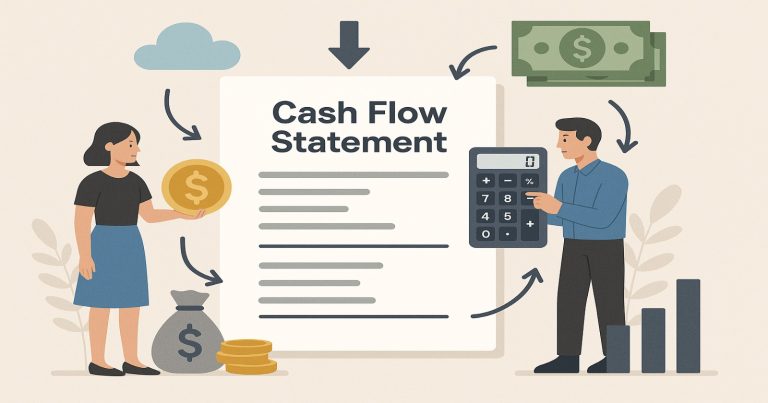A cash flow statement is considered the most important financial document as it documents how money enters and leaves a business during a specified period. The inflow and outflow of cash have to be documented for a company, as this would tell the world how well that company has managed its cash position for funding operations, liabilities, or investments. As this financial statement presents a detailed report on cash transactions only, it is considered one of the crucial tools for liquidity and cash management along with the income statement and balance sheet.
What is a Cash Flow Statement?
A cash flow statement is that financial report that indicates the inflow and outflow of cash during an accounting period. Being different from an income statement, which contains depreciation among other non-cash transactions, this will only exhibit the movement of cash, thus clearly defining the liquidity of a company.
A cash flow statement reflects the movement of cash inflows and outflows during a period and gives essential information on the health of a business. It is divided into three main aspects: operating, investing, and financing activities. Through the analysis of the cash flow statement, stakeholders may thereby derive a more accurate understanding of how a firm generates and spends cash if the business is liquid, and if it can generate cash to meet future needs.

Key Components:
- Operating activities: Directly related activities to the primary operations of a business, including receipts from sales and payments for goods and services sold.
- Investing activities: The purchase or sale of long-term assets, such as the purchase of equipment or the sale of investments.
- Financing activities: Cash flows related to issues of shares or the redemption of shares or loans obtained or issued. This includes dividends paid to shareholders or received, or loans received.
Importance of Cash Flow Statement
The cash flow statements are most important because they offer crucial insights for business stakeholders and financial analysts to assess the health of a business:
- Assessing Liquidity: Ascertains whether the firm is capable of meeting its short-term obligations such as paying suppliers or employees.
Cash Flow Forecasting: The cash flow statement gives businesses the ability to forecast their cash flow, allowing them to be on the lookout for expansions or stressful periods in the near future. - Investor Insight: Cash flow statements would be of great use for investors in understanding the company’s ability to pay out the dividend or reinvest the money back into the business.
- Operational Efficiency: It gives the measure of the conversion of profit into cash; it shows the real operational efficiency.
Debt Management: The cash flow statement showcases whether the company is capable of paying interest on loans and principal.
Objectives of Cash Flow Statement
The purposes of a cash flow statement are as follows:
- To improve knowledge in understanding cash position: It elaborates on cash inflows and outflows; hence, it helps provide relevant stakeholders with an idea of how cash is generated and spent.
- To monitor the movement of cash: Businesses can monitor the efficiency of their operations by analyzing the movement of cash over time.
- It facilitates decision-making: The cash flow statement is helpful in strategic decisions involving capital investment, financing, and budgeting.
- Compliance with Regulations: This means that compliance is achieved at times by presenting the cash flow statement as a basis for the statutory reporting requirements.
- Liquidity Analysis: The cash flow statement helps evaluate the capacity of the company in meeting short-term and long-term obligations, which makes it critical for investors and creditors.
How the Cash Flow Statement Is Used
Businesses and financial professionals use the cash flow statement in multiple ways:
- Analyzing Profitability: While net income is an important measure, it is equally important to know how much of this profit is in cash. The cash flow statement will assist in distinguishing between net income and cash available.
- Evaluating Investment Opportunities: Cash flow in the investment activities will help stakeholders analyze the strategy of a company regarding investments made in purchasing or selling assets.
- Debt and Equity Analysis: Financing activities on the cash flow statement inform whether a company is borrowing more, paying down, or issuing equity; hence, it gives clues into its capital structure.
- Cash Flow Projections: By looking at past cash flows, businesses can estimate when cash will be available. This helps manage growth and avoid liquidity crises.
- Budgeting and Planning: A cash flow statement really helps in preparing much more accurate budgets, as it explicitly tells the trend of cash generation and spending.
Difference Between Cash Flow Statement and Fund Flow Statement
The difference between cash flow statement and fund flow statement lies in their scope and focus:
| Feature | Cash Flow Statement | Fund Flow Statement |
|---|---|---|
| Focus | Tracks cash inflows and outflows | Tracks changes in working capital |
| Primary Objective | Shows cash position of the firm | Analyzes financial position changes over time |
| Components | Operating, Investing, and financing activities | Sources and uses of funds |
| Preparation Basis | Actual cash movements | Accrual basis, focusing on funds |
| Time Frame | Short-term liquidity and cash flow | Long-term financial strategies |
While the cash flow statement provides a picture of liquidity, the fund flow statement offers insight into the overall financial health by analyzing sources and uses of funds.
Cash Flow Statement FAQs
1. How does the cash flow statement help in decision-making?
The cash flow statement aids decision-making by offering insights into a company’s cash position, helping management forecast future cash needs, and identifying areas for cost optimization.
2. What is the difference between cash flow and profit?
Cash flow refers to the actual movement of cash in and out of a business, while profit represents the surplus after all expenses are deducted from revenues, including non-cash items like depreciation.
3. Why is the cash flow from operations important?
Cash flow from operations shows the cash a company generates from its core activities, which is crucial for day-to-day operations and indicates the firm’s efficiency in generating cash from its regular business activities.
4. Can a company be profitable and still have cash flow problems?
Yes, a company can show profits on its income statement but still face cash flow issues if it fails to collect receivables or has significant cash outflows that exceed inflows.
5. What is the difference between the cash flow statement and the fund flow statement?
A cash flow statement tracks actual cash movements, while a fund flow statement analyzes changes in working capital, highlighting long-term financial strategies.


